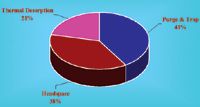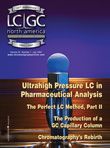Volatile Extraction Market
The volatile extraction market consists of three techniques: purge and trap, headspace, and thermal desorption equipment. These systems are often employed as a sampling method for gas chromatography (GC) instrumentation but are also used with IR detectors, electrochemical sensors of electronic noses, and mass spectrometers.
The volatile extraction market consists of three techniques: purge and trap, headspace, and thermal desorption equipment. These systems are often employed as a sampling method for gas chromatography (GC) instrumentation but are also used with IR detectors, electrochemical sensors of electronic noses, and mass spectrometers.
The volatile extraction market is primarily a systems market with purge and trap accounting for the largest market share. Purge and trap involves the bubbling of an inert gas, such as nitrogen or helium, through an aqueous sample, which liberates the volatile organic compounds (VOCs) that are either dissolved in the sample or present in a solid sample that is then suspended in the aqueous sample. Purge and trap technology enables GC and GC–MS systems to achieve lower levels of detection. Headspace, however, is the most common volatile extraction technique in terms of units sold. Industries with the highest demand for headspace extraction are chemical, forensics, food and beverage, pharmaceutical, and environmental testing.

Volatile Extraction Market.
Thermal desorption systems are efficient and highly sensitive. But, shortcomings of the technology have limited its market share. Still, thermal desorbers are widely used for environmental testing, often in the monitoring of air quality, chemical exposures in workplaces, and identifying fragrances and other ingredients. Thermal desoprtion systems are especially common in countries where environmental monitoring is of greater concern such as China and part of Latin America.
Most GC vendors manufacture volatile extraction equipment or they have OEM arrangements with volatile extraction vendors in order to offer complete analytical solutions to their customers.
The foregoing data was extracted from SDi's "Market Brief on Volatile Extraction." For more information, contact Glenn Cudiamat, VP of Research Services, Strategic Directions International, Inc., 6242 Westchester Parkway, Suite 100, Los Angeles, CA 90045, tel. (310) 641-4982, fax (310) 641-8851, e-mail cudiamat@strategic-directions.com.
Detecting Hyper-Fast Chromatographic Peaks Using Ion Mobility Spectrometry
May 6th 2025Ion mobility spectrometers can detect trace compounds quickly, though they can face various issues with detecting certain peaks. University of Hannover scientists created a new system for resolving hyper-fast gas chromatography (GC) peaks.
Altering Capillary Gas Chromatography Systems Using Silicon Pneumatic Microvalves
May 5th 2025Many multi-column gas chromatography systems use two-position multi-port switching valves, which can suffer from delays in valve switching. Shimadzu researchers aimed to create a new sampling and switching module for these systems.
New Study Reviews Chromatography Methods for Flavonoid Analysis
April 21st 2025Flavonoids are widely used metabolites that carry out various functions in different industries, such as food and cosmetics. Detecting, separating, and quantifying them in fruit species can be a complicated process.

.png&w=3840&q=75)

.png&w=3840&q=75)



.png&w=3840&q=75)



.png&w=3840&q=75)











